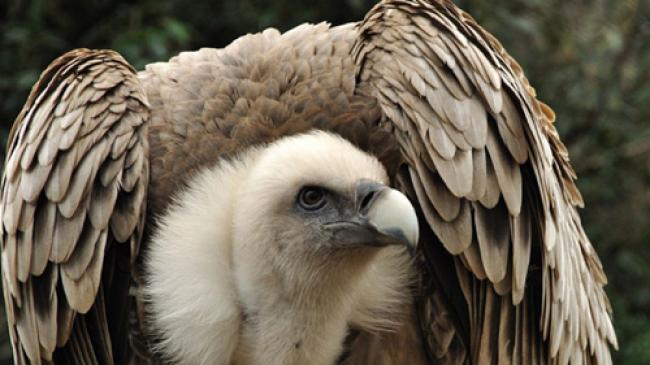
Vulture is a patient bird
Their dedication to the work nature has endowed them with – to rid the world of carrion – should have earned them kudos as virtuous workers but alas, it is the very thing that turned them into villains. And their apparently ugly shape – bald and featherless – and characteristics such as ability to spot a carcass from high and eat putrefied flesh have made vultures one of nature’s least liked children. With the Zoroastrians leaving their dead exposed to the sun and the birds of prey, mostly vultures, has heightened the bird’s symbolic association with death. The bird is loathed so much that during a visit to Pench National Park in Madhya Pradesh, we found few visitors interested in observing the vultures when we happened to spot a group. Hence, when these once abundant birds across India started disappearing, few noticed the loss.
According to some reports, in the early 1990s, people in certain north Indian regions began to notice that a large number of cattle carcass were lying around; earlier the vultures would dispose of the carcass but not anymore. Soon, other areas in India began to notice a decrease in the number of vultures. Researchers too began to note the drastic fall in the number of the birds. Vibhu Prakash, a biologist with the Mumbai-based Bombay Natural History Society (BNHS), had recorded nearly 350 breeding pairs of white-backed (white-rumped) vultures in Keoladeo Ghana National Park (Rajasthan) in 1987. He found only 150 pairs in 1996, which dwindled to 25 the following year and in 1999 there were none.
India has nine species of vultures, of which the white backed (Gyps bengalensis), long-billed (Gyps indicus), slender-billed (Gyps tenuirostris) vultures are endemic to South Asia. According to researchers, the number of all these three Indian Gyps vultures – believed to be among the most numerous birds of prey in the world prior to the 1990s – had dipped sharply in the decade since then; the number of white-backed had declined by 99% while that of the other two by almost 97%. The birds were declared critically endangered by the International Union for Conservation of Nature (IUCN).
Prakash and other researchers observed that in many areas vultures were sitting on branches with their necks drooping on their chests and appeared lethargic. Vultures in India are part of the Accipitridae family; the species from this family are known for their ability to find food by sight rather than smell. The birds, their wings spread out, would fly over large areas looking for food. Hence the lethargy in the birds was strange indeed. Researchers from Pakistan and Nepal also began to report the decline in the number of vultures seen in these countries.
Vultures are seen as a key species in the ecological chain. In countries such as India, where there is no large scale disposal system to take care of dead cattle and slaughter house waste, the vultures keep the environment clean and disease-free. Besides, their disappearance also encouraged the increase in the number of feral dogs and rats, which were proving detrimental to human health.
Supported by BNHS and other international bodies, researchers began to frantically search for the cause resulting in the humongous decline in numbers. Samples of dead birds were dispatched to pathological centres to determine the cause of death. Efforts were also being made to capture young birds from the wild and start captive breeding programmes at preselected sites.
Many tests later, in 2003, researchers from the Peregrine Fund found the answer – diclofenac, a non-steroidal anti-inflammatory drug. The drug was being widely used to treat sick cattle in the Indian subcontinent. Further studies confirmed their findings. When the contaminated dead cattle were dumped for the birds to devour, the toxicity was killing the birds. Vultures nest once a year and lay a single egg. This restricts the growth in the number of birds. Now felled by diclofenac, the birds hardly had a chance of survival.
After much advocacy by conservation organisations, in 2006, the Drug Controller General of India banned the veterinary use of diclofenac. Pakistan, Nepal and recently Bangladesh too have enforced similar bans. It has not been clearly understood yet why diclofenac affects the vultures but not other animals, like the feral dogs, that eat the contaminated carcasses, the ban has started yielding results.
Although diclofenac has now been established as the root cause of the drastic decline in the number of vultures, some naturalists do not rule out the overall negative impact from decrease in green cover, the use of pesticides and activities such as destruction of bird life around airports.
Realising that banning the drug is not sufficient to stabilise the number of vultures in the wild, BNHS, with financial support from the UK-based Royal Society for the Protection of Birds (RSPB), has been instrumental in setting up three vulture conservation breeding centres at Pinjore (Haryana), Rajabhatkhawa (West Bengal) and Rani (Assam). Besides, in association with Rio Tinto and BirdLife International, BNHS is all set to establish a Vulture Safe Zone (VSZ) in the Bundelkhand region of Madhya Pradesh. The VSZ is ideal for introducing captive bred vultures into the wild. Although one cannot be sure if the drug is still being illegally manufactured and used, researchers believe that the ban coupled with other supporting efforts have begun to yield results and the number of vultures in the wild may stabilise in the near future.
Images courtesy Desktopnexus.com
Support Our Journalism
We cannot do without you.. your contribution supports unbiased journalism
IBNS is not driven by any ism- not wokeism, not racism, not skewed secularism, not hyper right-wing or left liberal ideals, nor by any hardline religious beliefs or hyper nationalism. We want to serve you good old objective news, as they are. We do not judge or preach. We let people decide for themselves. We only try to present factual and well-sourced news.







